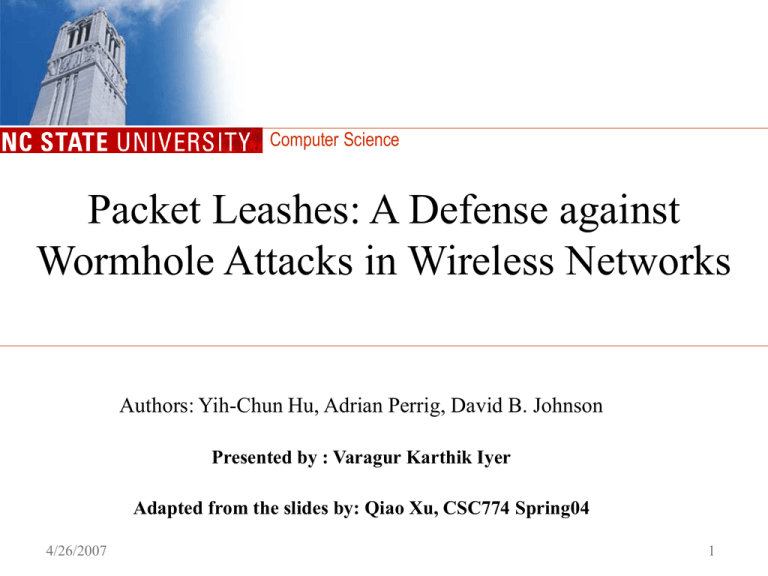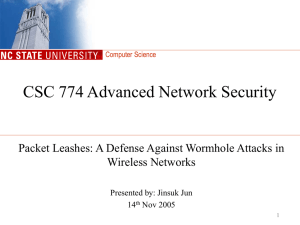Packet Leashes: A Defense against Wormhole Attacks in Wireless Networks Computer Science
advertisement

Computer Science Packet Leashes: A Defense against Wormhole Attacks in Wireless Networks Authors: Yih-Chun Hu, Adrian Perrig, David B. Johnson Presented by : Varagur Karthik Iyer Adapted from the slides by: Qiao Xu, CSC774 Spring04 4/26/2007 1 Outline • • • • • Introduction Temporal Leashes TIK Protocol Performance & Security Analysis Future Work & Conclusion Computer Science 4/26/2007 2 Introduction • Problem: Wormhole Attack – An attacker records packets at one location of the network, tunnel them to another location, and retransmits them there into the network – Wormhole attack allows attackers to: • Gain unauthorized access • Disrupt routing • Perform DOS attacks • Solution: Packet Leash – Add information into the packet to restrict its maximum allowed transmission distance Computer Science 4/26/2007 3 Illustration of a wormhole attack • A mobile wireless ad hoc network • Nodes S and D communicate through wireless multi hop routing Normal Operation S D Computer Science 4/26/2007 4 Illustration of a wormhole attack • A mobile wireless ad hoc network • Nodes S and D communicate through wireless multi hop routing Colluding Attackers Under Attack S Wormhole Computer Science 4/26/2007 D 5 Packet Leashes • Goal – Limit the distance traveled by a packet in a network Colluding Attackers • Approaches – Two approaches to the achieve the goal • Space : geographical leashes S Limit the range of the packet using the distance it can travel • Time : Temporal Leashes Limit the range of the packet using the time it remains valid Computer Science 4/26/2007 Wormhole D 6 Geographical Leashes (Overview) • Definition: a geographical leash establishes an upper bound on the distance that a packet can travel • Requirements – Every node must have knowledge of its location – Loose time synchronization – Nodes can be relatively mobile • Geographical leashes also enable multiple location detection Computer Science 4/26/2007 7 Temporal Leashes • Definition: a temporal leash establishes an upper bound on a packet’s lifetime, which restricts the maximum travel distance • Key Requirement: all nodes must have tightly synchronized clocks – Maximum clock difference (Δ) between any two nodes must be within a few microseconds Computer Science 4/26/2007 8 Temporal Leashes • Implementation with a packet expiration time • Sender calculates a packet expiration time to be sent with each packet: te = ts + L/c – Δ – te: packet expiration time – ts: packet sent time – c: propagation speed of wireless signal – L: maximum allowed travel distance; L > Lmin = Δ*c – Δ: maximum clock difference between 2 nodes Computer Science 4/26/2007 9 Temporal Leashes • Receiver will accept and process a received packet if and only if the time when the packet is received (tr) is less than the packet expiration time (te) • What’s missing? – Need an efficient way for the receiver to authenticate te Computer Science 4/26/2007 10 TIK Protocol - Overview • TIK – TESLA with Instant Key disclosure – TIK implements a temporal leash and provides efficient instant authentication for broadcast communication in wireless networks – Based on the observation that a receiver can verify the TESLA security condition, that the corresponding key hasn’t been disclosed, as it receives the packet, this allows sender to disclose the key in the same packet – Assume sender can precisely predict ts and receiver can record tr as soon as the packet arrives – Requires accurate time synchronization between all the nodes Computer Science 4/26/2007 11 TIK Protocol – Sender Setup • Sender generates a series of keys, K0, K1,…, Kw-1, using a PRF F and a secret master key X: Ki = Fx(i) • Sender selects a key expiration interval I and determines the expiration time (Ti) for its keys: Ti = T0 + i*I, where T0 is the expiration time for K0 • Sender constructs a Merkle hash tree to commit to keys: K0, K1,…, Kw-1 Computer Science 4/26/2007 12 TIK Protocol – Merkle Hash Tree m07 m03 m01 m47 m23 m45 m67 K 0’ K1’ K2’ K3’ K4’ K 5’ K 6’ K 7’ K0 K1 K2 K3 K5 K6 K7 Computer Science 4/26/2007 K4 13 TIK Protocol – Merkle Hash Tree • How is it constructed? – For every leaf node, Ki’ = H(Ki); i.e. K0’ = H(K0) – For every parent node, mp = H(ml || mr); i.e. m01 = H(K0’|| K1’), m03 = H(m01 || m23); • The root value (m07) is signed by the sender and sent to the receivers, where it can be authenticated with sender’s public key • To authenticate K2, for example: – Sender must include K3’, m01, m47 in the packet – Receiver computes m07’ and compare to the pre-distributed m07 m07’ = H[ H[ m01 || H[ H[K2] || K3’]] || m47 ] Computer Science 4/26/2007 14 TIK Protocol – Receiver Bootstrapping • Assume all nodes are synchronized with a maximum clock difference of Δ • Assume each receiver knows every sender’s hash tree root value and the associated parameter T0 and I Computer Science 4/26/2007 15 TIK Protocol – Sending and Verifying Packets Sender HMAC M Receiver HMAC Time at Sender •Time at Receiver ts T Ki M T Ki Ti •tr ≤ (ts + т - Δ) •≤ (Ti - Δ) Computer Science 4/26/2007 16 TIK Protocol – Sending and Verifying Packets • S → R: (HMACKi(M), M, T, Ki) – M: message payload – HMACKi(M): message authentication code for M – Ki: key used to generate the HMAC for M – T: tree authentication values used to authenticate Ki • Receiver: – Verifies if the sender has started sending Ki after receiving HMAC, based on Ti – Verifies if Ki is authentic based on the hash root value and T – Verifies the HMAC, using authenticated Ki – Accept the packet as authentic only if all those verifications are successful Computer Science 4/26/2007 17 Security & Performance Analysis • Security Analysis – Temporal leash with TIK protocol can detect and prevent wormhole attacks if all nodes are good nodes – Can’t deal with a malicious sender that claims a false timestamp – Can’t deal with a malicious receiver that refuses to check the leash • Performance Analysis – Requires only n public keys in a network with n nodes – Efficient hash tree authentication of keys – Efficient instant authentication of packet because the key is disclosed in the same packet – Modest storage requirement for the Merkle hash tree Computer Science 4/26/2007 18 Related Work • RF-Watermarking – Modulating the RF waveform in a way known only to authorized nodes – Vulnerable to node capture • Intrusion Detection – Hard to isolate attacker using a software only approach, since it is hard to distinguish malicious traffic from legitimate traffic Computer Science 4/26/2007 19 Future Work & Conclusion • Future Work – An efficient implementation of Geographical leashes – Securing TIK against node misbehavior (sender/receiver) – Achieving accurate time synchronization among the nodes • Conclusion – Wormhole attack is a powerful and disruptive attack against wireless networks – With precise timestamps and tight clock synchronization, TIK can prevent wormhole attacks Computer Science 4/26/2007 20 Thank You! • Questions and Comments Computer Science 4/26/2007 21







